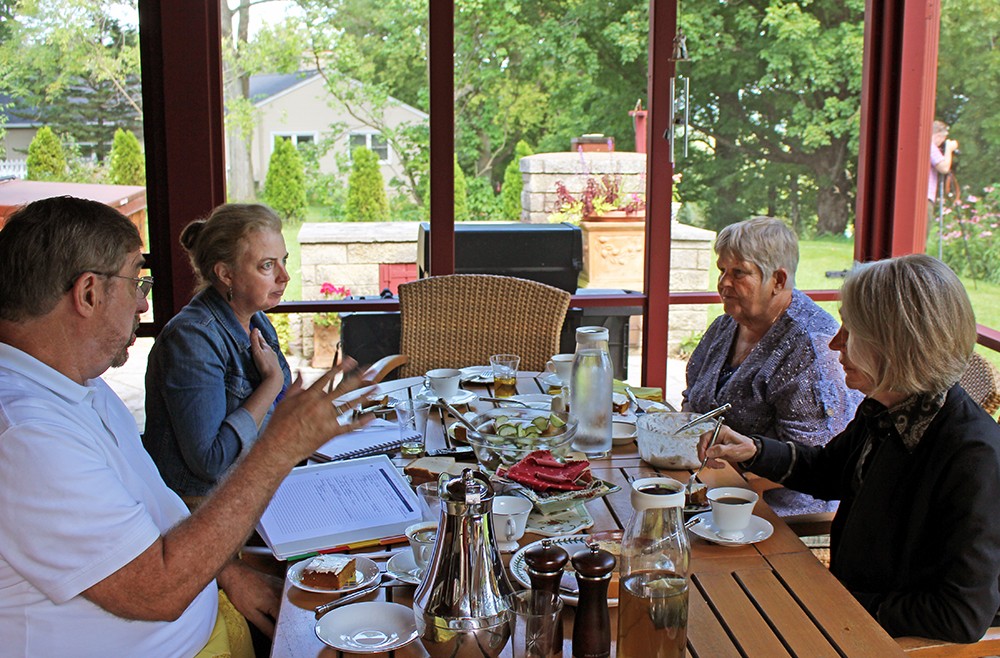‘You’ve cultivated this really strong sense of giving’

The Community Foundation of Greater Dubuque (CFGD) and its rural affiliates recently hosted Betsey Russell and Kim Moore, consultants assisting the Robert Wood Johnson Foundation in the creation of several case studies on rural philanthropy.

“Our goal is to capture the stories of what’s going on in rural places with local or regional funders, and tell those stories in a way that makes a national or regional funder recognize the value there,” the consultants said, explaining that while 20 percent of the nation’s population lives in rural areas, those regions receive just 7 percent of nationwide philanthropic funding.
Russell has 25 years experience writing for and about philanthropy, and Moore spent over three decades running the United Methodist Health Ministry Fund in Kansas. The two visited state and regional health funders in Washington State, New Hampshire, and Maine before traveling to Iowa, and went on to New Mexico for their final case study. CFGD was the only community foundation chosen to participate in the study because of its unique approach to rural philanthropy and affiliate support.
Russell noted the importance of recognizing local leadership and the effectiveness of rural philanthropy in places with formal connectors like CFGD and its dedicated affiliate staff. Each of CFGD’s seven rural affiliate foundations has its own local board, local coordinator and a designated staff contact at the Dubuque headquarters. “What I would say we haven’t seen other places is this foundation’s commitment to having foundation boots on the ground in these communities,” she said. “We suspected that’s a great approach, but we haven’t seen it with the regional and state level funders.”
After a Q&A with key CFGD staff, Russell, Moore and photographer Shawn Poynter hit the road in Eastern Iowa, visiting with representatives from Allamakee, Clayton, Clinton, Jackson and Jones counties.
Russell and Moore were curious about the support CFGD provides to its rural affiliates and the value of affiliation with a larger foundation. LincolnWay Community Foundation (LWCF), for example, affiliated with CFGD after establishing its own tradition of community stewardship in Clinton County. “As the Foundation grew the requirements for more record-keeping sophistication became apparent, particularly because of the Endow Iowa tax credit program,” said Al Tubbs, philanthropist and chief executive officer at Ohnward Bank. “A community foundation has to be accredited and follow standards to give those credits.”

Pastor Harold McMillin, long-time Clayton County for the Future (CCFF) board member, echoed those sentiments. “We don’t have the resources here to understand all the investments,” he said. “We just don’t have that background, so we have to trust others like we trust our doctor, like we trust our pastor, like we trust our lawyer. They’ve taken on a lot of leadership in Dubuque that has really helped us blossom.”
Andy Reimer, financial advisor and CCFF board member, identified another benefit of his county foundation’s affiliation with CFGD: access to a graphic designer, website maintenance and communications staff. “The big thing is the nice-colored literature that has everything laid out so I can show people, ‘This is where your money is; this is who’s watching it,’ with real-life examples of people they know,” he says.
“The one question they asked that I thought was really interesting was, ‘Why should a national foundation consider giving money to a rural region like this?’” Reimer said. “We’re part of society, too — we just don’t have the population. We know how to stretch the dollars, and, in most situations, we probably know the person behind the project.”
Jane Hasek of Harpers Ferry is one of three CFGD board members who represent the rural affiliates. “From a board perspective, it’s really important to have the voice of the affiliates,” she told Moore and Russell. “You need the county affiliate because you need the voice and you need the people in the community to be doing the planning.”
At the conclusion of their three-day visit, Russell and Moore left with a better sense of how the Community Foundation supports its rural affiliates and how the affiliate representatives can tap into their communities’ generous spirits. “You’ve cultivated this really strong sense of giving, which is also one of the characteristics of rural that really stands out,” Russel said. “I think the next step is to think, okay, so we are great fundraisers. Now how do we become strategic grant makers, and then, how do we become transformative grant makers?”
The case studies will be published by Campbell University in early 2019.